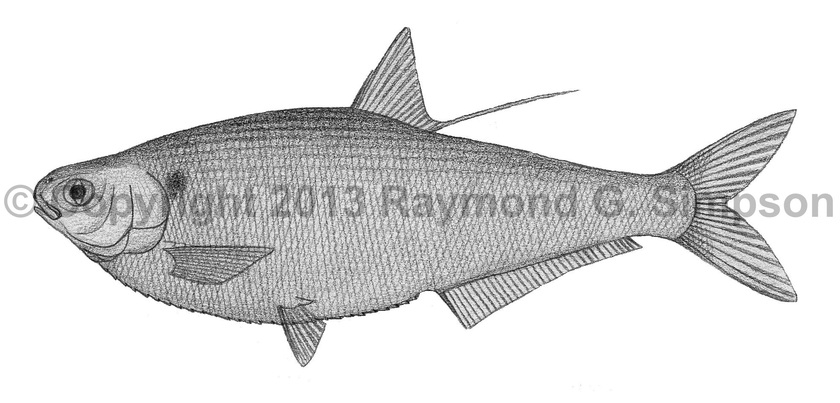
Common Name
Mexican Gizzard Shad
Year Described
Meek, 1904
Identification
Dorsal Fin: 10-13
Anal Fin: 29-38
Pectoral Fin:
Pelvic Fin: 8 (7 branched)
Vertebrae: 43-48
Lateral Line Scales: 73-78
Ventral Scutes: 28-29
Gill Rakers:
Body deep and compressed. Mouth subterminal and very small. Snout protruding and rounded. Jaw does not reach eye. Front of upper jaw notched (unique to Dorosoma, Alosa, and Brevoortia. Lower jaw fits into notch in upper. Dorsal fin single with a filamentous final ray. Pelvic fin origin in front of dorsal fin origin. Anal fin begins under last dorsal ray and is long based and low. Tail forked. Body fully scaled (scales small). Ventral keel strong and convex.
Color
Bright silvery body with a bluish-black back. Often with a golden sheen when fresh. A dark blotch posterior to the upper gill cover on lateral line. Fins dusky. Eye golden.
Size
Maximum size to 24cm TL. Usually <20cm SL.
Habitat
A freshwater species found in deep river basins, satellite streams and lagoons. Salinity tolerance not known.
Range
Rio Usamacinta drainage, Mexico.
References
Whitehead, P.J.P. 1985. FAO Species Catalogue. Vol. 7. Clupeoid fishes of the world (suborder Clupeioidei). An annotated and illustrated catalogue of the herrings, sardines, pilchards, sprats, shads, anchovies and wolf-herrings. FAO Fish. Synop. 125(7/1):1-303. Rome: FAO.
Other Notes
Included as this freshwater species is closely related to the other marine species in the genus Dorosoma. Can be easily distinguished by range but also has higher scale counts and lower vertebra counts than D. cepedianum.
Two other Dorosoma are found in the freshwaters of Mexico and Central America: Dorosoma chavesi (Nicaragua) and D. smithi (NW Mexico). Both have lower anal fin counts and shorter dorsal filaments in adults.